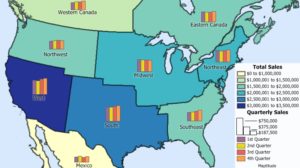Why ignoring this concept is costing you money and what to do about it.

Let’s face it, sales professionals come and go, but territories tend to be permanent.
If you think about it, even if we divide up a territory into smaller pieces, or recombine multiple territories in some fashion, the individual targets within them stay the same. Therefore, I would argue that territories are permanent even when the deck is re-shuffled. So, as I like to say, shame on me if my territories are not stronger, warmer and better defined a year from now than they are today.
There are two reasons why this is important:
- There is the potential for lost sales revenue every time there is turnover in a territory because requests for call backs and momentum gained through previous pursuit plans can be lost when territories are transferred from one sales professional to another if there is no way to track activity and results.
- Reduction of sales professional turnover. One of the reasons we see turn over on sales teams is because new sales professionals can’t close enough new sales in their first year on a job. Once again calling on the same unqualified targets that have been disqualified by earlier efforts is not only inefficient and expensive; it is demoralizing to the new rep. Easily transferring the results of past work and leveraging the efforts of past reps mitigates this.
Here’s what happens in most companies we work with. They hire another sales professional to come in behind the one that just left and give the new person exactly the same list the old one prospected from. He or she will call on all of the same targets, usually starting at the top of the list again getting exactly the same responses that the departed rep did (except that some of those targets might even now begin to become irritated and rude because they’ve now told numerous reps of yours to leave them alone).
Let’s assume for a moment that the departed rep was a reasonably good sales professional and did the job well, calling on 1,000 different businesses before they left. He/she determined that 500 of those were unqualified (not unreasonable on a virgin list.) They quit because they had to spend way too much of their time talking to and qualifying out those 500, so they couldn’t make enough money. Wouldn’t it be better if your new sales professional didn’t go call on those same 500 again?
Finding a good quality list with nothing but qualified targets on it is problematic at best. List manufacturers themselves will tell you a list is obsolete the day they send it to you. You’ve also most likely spent good money on marketing programs that got someone to raise their hand and say they were interested. But even that list grows stale over time. So, if you think just having a list for a sales professional to call on solves the problem, you’re just flat wrong.
One last thought. CRMs are not the answer. By definition (the ‘C’ in CRM stands for customer, not target, suspect or prospect), so they are good at keeping track of customers. They are also good at managing forecasts of current prospects who have entered into buying cycles with you. They were never designed to be efficient for prospecting, although they are sold as the sales professional’s Swiss Army Knife. CRMs are not only inefficient and ineffective at this task, they’re downright counterproductive. The point is they are so cumbersome to use for this task that sales professionals just won’t use them, or if they do, the process adds to their frustration level so much that it adds to your turnover problem—Catch22.
Our suggestion is to use a product from Contact Science called PROSPECTING. (It used to be called Klpz.) It is the only automation we’ve found that was actually designed to be used for prospecting, and appointment setting in particular. (We use it every day.)
It solves all of the challenges I mention above, paying for itself many times over even before one takes into account the many other advantages to using it for the task of appointment setting.
If you’re interested in some benchmarks on the topic, let me know. I’ll send you some results of side by side comparisons of CRMs vs PROSPECTING. Or, if you’re interested in why no team of sales professionals has ever failed to at least double the number of Initial Appointments they were setting after going through one of our programs, give us a call or drop us a line. (Part of the increase comes from the efficiencies the PROSPECTING tool brings to the table.) We love talking about the challenges of appointment making!
Caponi Performance Group and Contact Science jointly market the telephone prospecting and cold calling solution called Coldcalling101™. It is the only comprehensive solution to solving the biggest barrier to success in most selling organizations—the inability to secure enough Initial Appointments to begin the selling process. We accomplish that through simultaneously addressing both the efficiency and effectiveness of the process. We can be reached at 817 224-9900 or at bcaponi@caponipg.com. You can also find answers to many of your challenges in our books: Contrary to Popular Belief, Cold Calling DOES Work! Volume I: Effectiveness, The Art of Appointment Making and Volume II: Efficiency, the Science of Appointment Making.
Share and Enjoy